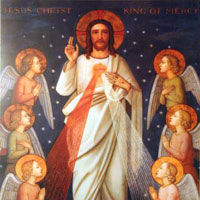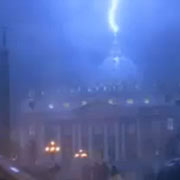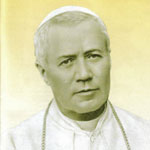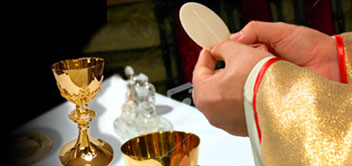The Divine Mercy image has quickly become ubiquitous. I imagine most Catholics in most parts of the world would recognise it. Not bad for an image which was painted only 80 years, suppressed by the Holy See, and rehabilitated less than forty years ago.
The image has three-fold significance.
1. The Resurrection and the Life
In the first place, it is a depiction of today’s Gospel: the appearance of Jesus to his apostles on the evening of Easter Sunday.
Our Lord appears unexpectedly, despite the locked doors, points to his wounds, and raises his hand in blessing. “Peace be with you,” he says. “Shalom!”
He says it twice, because “Shalom!” is a common Jewish greeting. But the peace our Lord gives is not common. It is a peace the world cannot give: the gift of the Holy Spirit.
2. Crucified Saviour
In the second place, the image is a depiction of Christ on the cross. The rays of red and white light evoke the blood and water which flowed from Jesus’ side.
The Church’s origin and growth, Vatican II teaches, are “symbolized by the blood and water which flowed from the open side of a crucified Jesus.”
The Divine Mercy chaplet describes the stream “as a fount of mercy” which covers the world.
3. Eternal High Priest
In the third place, the image depicts Jesus as the eternal high priest. He is portrayed mid-step, emerging from the heavenly sanctuary. The holy of holies.
He is dressed in the white linen of the High Priest. White linen also adorns Catholic altars. During the Mass, the altar is the principal symbol of Christ.
Just as the Divine Mercy image is priestly, so are the prayers of the Divine Mercy chaplet:
Eternal Father, I offer you the body and blood, soul and divinity of your dearly beloved Son, our Lord Jesus Christ, in atonement for our sins and those of the whole world.
For the sake of his sorrowful passion, have mercy on us and on the whole world.
This prayer is really a summation of the Mass. In the Eucharist, the priest offers the bread and wine, which become the body and blood of Christ. But not the priest alone. In the preparation of the gifts, the priest addresses the people:
Pray brothers and sisters, that my sacrifice and yours may be acceptable to God, the almighty Father.
Everyone at Mass makes the offering. It’s as though we’re transported to Calvary. We stand beside our Lady, at the foot of the cross, and we offer the body and blood of Christ.
We can do this only because of the Holy Spirit and the sacraments. In baptism, we become sharers in Christ’s priesthood, and members of his body. We enter into him. In holy communion, we receive his body and blood. He enters into us. We become “one body one spirit in Christ.”
This is why, on Divine Mercy Sunday, we are especially encouraged to go to communion. We do this “for the sake of the whole world.”
But we’re also asked to embody divine mercy. To forgive those who hurt us. To love the unlovable. We cannot give what we have not received. So we’re encouraged to go to confession. If not today, then within the week.
Sacramental confession
If you haven’t gone to confession for a while, now is the time! If it has been a long while, it’s advisable to write out a list. If you’re not accustomed to confession, it can be nerve-wracking, and the mind easily goes blank! When preparing a list, a good examination of conscience can help.
If you’re in Melbourne, the sacrament is easily obtained at St Francis. On some days, confessions are heard for a cumulative 5½ hours! Unless it’s Sunday, Monday or a public holiday. In that case, try St Mary Star of the Sea, where the sacrament is available for about two hours every day of the year.
Today’s gospel describes the institution of the Sacrament of Reconciliation. After wishing the disciples peace (twice), the Lord breathes on them:
Receive the Holy Spirit. For those whose sins you forgive, they are forgiven.
The Gospel situates Reconciliation as the sacrament of peace. It’s easy to see why. Sin deprives us of peace. It troubles our conscience. It estranges us from our neighbours — especially those whom we love — and from God.
But when we name our sins, they lose their grip over us. Sacramental confession restores the peace Jesus offers us. It restores our relationships, reconciling us with our neighbours, with God, and with ourselves.
It also enables us to embody mercy. Just as we are forgiven, so we forgive.
And it sanctifies us. The grace and peace we receive can then attract others to Christ. The indwelling of the Holy Spirit is invisible, but still it is noticeable. People who have never seen Christ may yet believe in his resurrection through our witness, if we bear the peace and mercy our Lord offers us.
So go ahead! Celebrate Divine Mercy by both receiving it, and bestowing it!







Like! My favourite devotion!
“This prayer is really a summation of the Mass.”
Indeed! On occasion I get the opportunity to offer a class on the Mass and this has been my choice for the opening prayer.